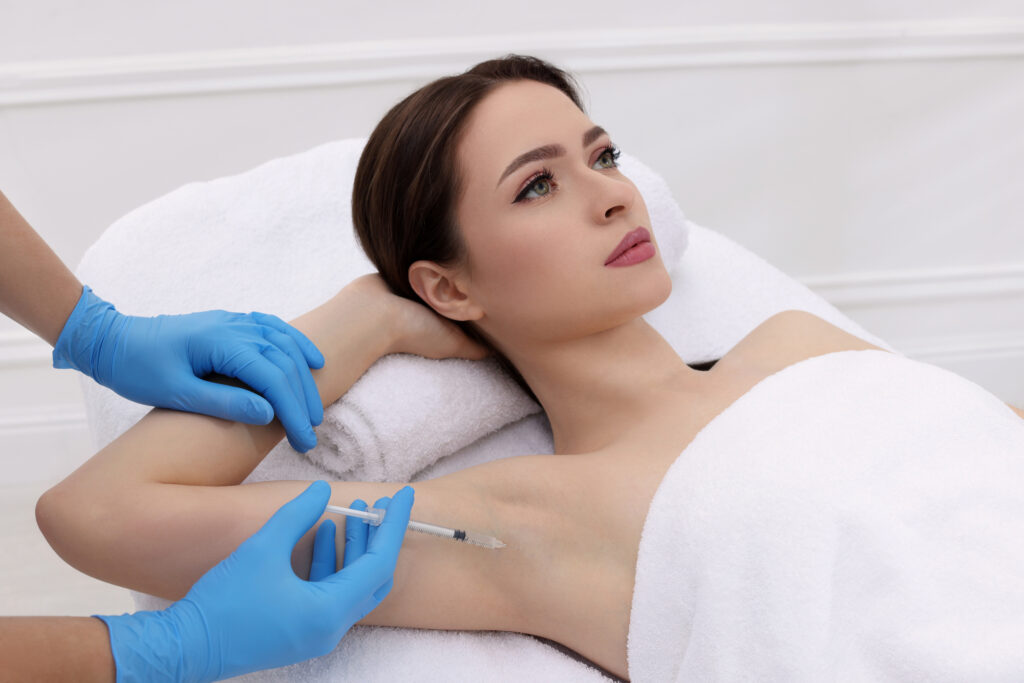
Clinical trials have shown that Botox is an effective treatment for hyperhidrosis.
Are you grappling with persistent diaphoresis, hindering your comfort and self-assurance in daily activities? Hyperhidrosis, affecting 3 percent of individuals, is characterized by abnormal perspiration. Beyond Botox’s anti-wrinkle reputation, it emerges as a transformative remedy. This exploration delves into hyperhidrosis, its symptoms, and the proficient role of Botox.
Understanding Hyperhidrosis and Its Symptoms
Hyperhidrosis involves excessive sweating, notably in palmar, plantar, or axillary areas. While not a health threat, it disrupts daily life. Classified as primary, linked to hyperactive sweat glands, or secondary, resulting from underlying conditions, seeking professional guidance is crucial for accurate diagnosis.
Hyperhidrosis, affecting millions globally, manifests as an exaggerated response of the body’s sweat glands. The palms, soles, and underarms are frequent trouble spots. While the condition is not inherently harmful, its impact on quality of life cannot be understated. Social discomfort, stained clothing, and impaired daily activities are common challenges faced by those with hyperhidrosis.
Primary hyperhidrosis, characterized by excessive perspiration, typically manifests during the teen years. Secondary hyperhidrosis, resulting from underlying health conditions like diabetes or thyroid issues, can emerge at any age. Accurate diagnosis hinges on consulting healthcare professionals who can evaluate medical history, conduct relevant tests, and provide tailored guidance.
Exploring Treatment Modalities for Hyperhidrosis
Potential alternatives to Botox are explored before the efficacy of the injection is assessed. Over-the-counter antiperspirants, often the first line of defense, may prove inadequate for severe cases. Prescription medications, ranging from antiperspirants to oral drugs, are viable options. In extreme scenarios, surgical interventions such as sympathectomy may be recommended.
Hyperhidrosis treatment plans are highly individualized, considering the severity of symptoms and the impact on daily life. Lifestyle adjustments, such as wearing moisture-wicking clothing or avoiding triggers like spicy foods, complement medical interventions.
Botox Injections: A Proficient Remedy for Hyperhidrosis
Contrary to its association with facial aesthetics, Botox has proven to be highly adept at treating hyperhidrosis through clinical trials. Rigorous studies confirm its efficacy in managing excessive sweating, providing a transformative solution. Botox employs a neuromuscular blockade mechanism, explicitly targeting the eccrine sweat glands.
Botox injections, typically administered in the affected axillary regions, temporarily paralyze the muscles responsible for excessive sweating. This intervention leads to a noticeable reduction in perspiration, providing relief for several months. When carried out by qualified professionals, the procedure is safe, underscoring its potential as a long-lasting treatment for hyperhidrosis.
Duration of Efficacy for Botox Treatments in Hyperhidrosis
Comprehending the temporal persistence of Botox’s effects is essential for those contemplating this intervention. The duration of efficacy varies among individuals, with many experiencing substantial improvement after just one treatment. While some people may need to inject themselves at regular intervals to keep the effects going, others find that intermittent treatments are all it takes. The response varies from person to person.
Potential Adverse Effects of Botox Injections for Hyperhidrosis
While Botox is generally safe, potential side effects are essential to consider. Transient muscular asthenia, local discomfort, ecchymosis, or edema at the injection site are common but temporary occurrences. Severe complications, such as Botox spreading beyond the injection site and causing dyspnea or paralysis, are exceedingly rare when administered by trained professionals.
Consulting a Healthcare Professional for Guidance
Consultation with medical experts is essential before considering Botox for hyperhidrosis. Variables influencing decision-making, including medical history, individual health conditions, and treatment preferences, necessitate insights from adept practitioners. A thorough consultation ensures that the chosen intervention aligns with the individual’s unique needs.
Cease Your Perspiration Woes: Secure Your Botox Appointment Today!
Excessive sweating no longer needs to impede your life. Botox appointments offer a transformative solution, providing relief from the challenges posed by hyperhidrosis. Advances in medical aesthetics have made hyperhidrosis management accessible, with Botox emerging as a beacon of hope for efficacious and enduring solutions.
Conclusion
In conclusion, hyperhidrosis, though not inherently harmful, significantly impacts the daily lives of millions of people. Botox injections, beyond their cosmetic applications, offer a transformative remedy for those grappling with abnormal perspiration. Understanding hyperhidrosis symptoms, exploring treatment modalities, and consulting healthcare professionals are crucial steps. With Botox emerging as a proficient and lasting solution, individuals can reclaim comfort and self-assurance in their daily activities.


